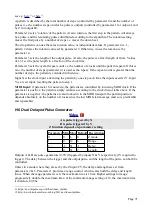
J-5 Audio Recorder
X is left audio input
Y is right audio input
Z controls recording
A is left audio output
B is right audio output
This algorithm records the incoming audio to a WAV file on the MicroSD card.
X & Y are the audio inputs. The incoming audio is echoed directly to the A & B outputs.
The Z knob/CV controls recording. When Z exceeds approximately 1V, recording starts. When it
falls below 0.5V, recording stops. If Z already exceeds 1V when the algorithm is started, it must fall
below 0.5V before recording can be started for the first time.
Do not remove the MicroSD card or power off the disting while recording is active,
as this could corrupt the card.
The recorded WAV files are stereo, 16 bit, 46.875kHz. The files are named sequentially starting
with REC00000.WAV (then REC00001.WAV, REC00002.WAV etc.). If there are already
recordings on the card, the next available filename will be used; the old files will not be
overwritten.
The files are placed in a folder named '!RECORD'
. If this folder does not exist, it will be created.
When recording is complete, a small text file will also be written to the card, with the same
filename but with the extension '.TXT'. This will detail any dropouts that occurred while recording
the file (or ideally simply 'No dropouts').
The disting's screen shows different information than the usual algorithm name or parameter values
in this mode. The left two columns of LEDs display level meters for the two audio inputs. The right
section of the screen either shows a rectangle (for recording stopped) or a recording animation
(when recording).
J-6 Multisample Audio Playback
14 The thinking behind this slightly odd name is that it places it alphabetically before any folder beginning with a letter,
and so it is likely to be the first folder in the list when switching to a playback algorithm – so if you want to rapidly
switch from record to playback, you don't have to scroll through a list of folders.
Page 85














































